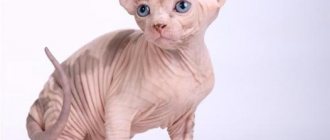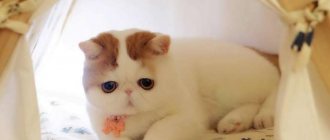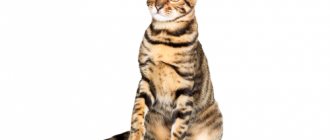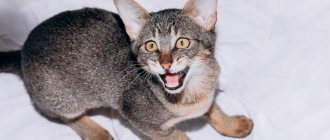Modern cat lovers are increasingly turning their attention not only to traditional breeds of furry pets, but also to their rather unusual representatives. It is these originals that include the Lykoi, an amazing breed that is steadily gaining popularity among breeders all over the world. The appearance of Lykoi is so unusual that they are compared to werewolves. Indeed, huge eyes and fur that grows in clumps suggest the exclusivity of these animals and their connection with the other world.
Brief history of the breed
Lykoi cats were bred in 2010 in the US state of Virginia. The history of the breed began with the fact that an ordinary short-haired female gave birth to babies with partially missing fur. The owner of the kittens, Patti Thomas, saw in the peculiar appearance of the newborns a resemblance to characters from horror films and began to call them Lykoi.
To understand the heredity of the unusual offspring, the American woman turned to the breeder of Canadian Sphynx dogs, John Gobble, for advice. He studied the issue in detail and found out that two similar kittens were born in Tennessee. This information gave hope for the emergence of a new exotic breed.
Genetic studies have shown that all four kittens have the same recessive gene in which a mutation has occurred. Breeders managed to very quickly consolidate the characteristics characteristic of Lykoi. And as a result of a special program, in which both pairs of the first cats participated, in the fall of 2011, kittens of the second generation were born with the same characteristic appearance. In 2012, the breed was recognized by American and some world felinological organizations.
Historical reference
The story of the cat Likoi begins in 2010, in the USA, the state of Virginia. As miracles tend to happen, the “phenomenon” of a new breed began in the small and inconspicuous yard of Patty Thomas. An ordinary short-haired cat became the mother of previously unseen kittens, with thinning fur and bald faces. Patti Thomas understood that she was dealing with something unusual, but did not rush things. The woman decided to make sure that there were no cats in the world with a similar appearance.
Given that the kittens were partially hairless, Patty contacted the Gobble couple, a reputable American breeder of Sphynx cats. John Gobble, who knows his business, was in no hurry to start breeding “outlandish animals”; the man also decided to check how unique the kittens were.
Having “studied” authoritative sources from the Internet, John came to the conclusion that the babies, whose photos Patti sent him, are nothing more than a miracle of nature, scientifically speaking - the result of a natural mutation. However, studying reports on the birth of unusual kittens was not in vain; the breeder came across a publication that in the USA, but already in the state of Tennessee, two more unusual kittens were born and their mother was a short-haired cat.
Successful people know that there are no coincidences in life and regard a successful coincidence of circumstances as a call to action. John, who has been involved in breeding since his school years, was determined to find out the reason for the birth of unusual babies and the state of their health. The Gobble family decided that if all the kittens turned out to be full-fledged and healthy, there would be a new breed!
While the professionals were doing the theoretical part, Patty watched the growth of unusual babies. The woman called the kittens Lykoi, for their similarity to horror movie characters. In the future, as a joke, Patty will suggest calling the breed Copossum, from the words cat and possum, however, the funny name will give way to mythical overtones.
John connected all his connections to fully investigate the kittens
Three geneticists worked to study the phenomenon, the kittens were examined for diseases and abnormalities, attention was paid to the health of the animals’ skin, and finally, DNA tests were carried out, proving that Lykoi does not have a common gene pool with the Sphinxes and Devon Rexes. Having made sure that Lykoi carries a unique natural mutation gene, together - four babies and a short-haired domestic cat
Having developed a breeding system, the breeders took action and by September 2011, the first “official” representative of Lykoev was received.
In order to consolidate the achieved results, domestic short-haired cats of suitable color (black and tan) were introduced into the program. In the process of work, the breeders found out that the unique gene is recessive and John Gobble reduced the participation of shorthair cats in the breeding program to a minimum. The breeders had ambitious plans to popularize the breed; a standard was drawn up in 2013, and recognition was expected by 2014. However, Lykoi remains in the provisionally recognized category due to its small population size.
Fans of the Likoi breed in Russia can only wait in the wings; werewolf cats have attracted the interest of many breeders from all over the world, which is a positive prerequisite for the popularization of unusual pets. It is also encouraging that searches are being conducted all over the world for naturally born Lykoi (from outbred parents) who are allowed to participate in breeding work.
Interesting facts about werecats
Despite the fact that the Lykoi have a short history, a lot of interesting things have happened to them:
- The name of this cat breed comes from the Greek word lykoi, translated meaning “werewolves” or “werewolves”.
- Due to their unusual appearance, which gives these pets a resemblance to fantastic creatures, representatives of the breed are often called werewolves, Licon cats or devil cats.
- Before Lykoi were bred, their characteristic color was found only in horses.
- Genetic tests have shown that representatives of the breed do not have the gene for hairlessness, which is characteristic of representatives of hairless cat varieties. Based on this, it was concluded that the Lykoi are not related to the Sphinxes and Devons.
Character of Lykoi
The Lykoi breed is very young and is not yet on the sales market, so we can judge the character of Lykoi cats only from interviews with the breeders of the founders of the breed.
According to them, Lykoi cats experience three main passions:
- The first is an amazing love and affection for a person, which does not fit in well with the terrifying appearance of these werecats. They truly adore the company of people and are very friendly and affectionate. But they treat strangers with some caution and wariness. That is why, with a little training, wolf cats cope well with the position of a house watchman or security guard, suddenly and very fiercely attacking an uninvited guest and sending him fleeing.
- The second passion of the Lykoi breed is increased playfulness. All free time is devoted to games and fun. If only there were more toys and people willing to play.
- The third passion of cat-wolves is quite surprising (especially when observing the condition of their fur) - they love grooming and are ready to do it forever.
And these amazing werewolves, as breeders joke, sometimes “pray” by taking a gopher pose and folding their front paws on their chest. In this position they can meditate for a long time while looking into the endless distance. And if at this moment you give your hand to the cat, then she always gives her paw in response. Here's a funny observation.
Werecats are always very active and mature much faster compared to other breeds, the same Sphynx, for example.
Lykoi cats are excellent hunters and in this they unexpectedly resemble the lively hunting dachshund dogs. Lykoi, like dachshunds, are always ready to chase
And it doesn’t matter who, an insect, a rodent or a bird. And here they behave very aggressively
Therefore, werecats are unlikely to be suitable companions for other pets: mice, hamsters and canaries. The Lykois will not tolerate such a neighborhood and will definitely solve this problem.
But in general, these shabby-looking animals really behave like real “werewolves”, as needed, becoming like either an affectionate cat, or an exemplary guard dog, or suddenly becoming a wild predatory beast. The creators of the breed do not recommend getting these cats for elderly people, families with small children or those who already have any pets, especially rodents and birds (for their own safety).
Description of the breed standards, appearance of the Lykoi
Lykoi are harmoniously built, thin-legged cats with expressive eyes and uneven coat. A breed standard with a detailed description of these animals was developed in 2012.
Dimensions and weight
Lykoy cats are not heavyweight breeds. The average weight of an adult female is 3.5 kg. The weight of a male can reach 4.5 kg.
Anatomical characteristics
According to the TICA standard, Lykoi cats must meet the following description:
- The head is medium in size, wedge-shaped, with soft contours, a slightly elongated forehead, a bald muzzle and fleshy, smoothly outlined whisker pads. The cat's nose is rounded and slightly pointed downwards.
- The eyes are large, slanted, with an open, penetrating gaze. A cat's iris is yellow, green or blue-gray.
- The ears are large, set far apart, with a wide base and pointed tips.
- The body is flexible, slightly elongated, thin, with well-developed muscles.
- The limbs are thin, of medium length, with oval paws and a bare lower part.
- The tail is short, gradually tapering towards the tip.
We recommend the article – “Top Most Scary Cats“.
Color and coat type
Lykoi are covered with soft, loose fur that grows in tufts, the thickness of which depends on the time of year. Due to the lack of down and a very thinned spine, it seems that cats of this breed suffer from a dermatological disease. And the bald patches on the face form a kind of mask.
The coat color of cats of this breed in professional terminology is referred to as roan. Each hair has a light gray or white base and a black tip.
On a note. Lykoi kittens are born with black fur. The graying characteristic of the breed appears on their coats as they grow older.
Possible breed defects
Disadvantages, in the presence of which a wolf cat will not receive a high rating for its exterior:
- limbs completely covered with fur;
- absence of a bald mask on the face;
- all color options except roan.
Breeding and choosing a kitten
Lykoi is a very rare breed, even in its homeland, in the USA. In America there are only 7 official kennels (one of them belongs to the creator of the breed, Britney Gobbles), which operate according to their own special breeding program and do not allow beginners into it. Lykoeys are still crossed with black shorthair cats and cats with a natural mutation in order to strengthen and improve the breed type and avoid impoverishment of the gene pool. For these reasons, Lykoeis are not sold for breeding. For the same reasons, there are no Lykoi nurseries outside the United States.
There are only 7 Lykoi nurseries in the world
However, it is quite possible to purchase a pet Lykoya by standing in line at one of the nurseries. The popularity of the breed is only gaining momentum, so you won’t have to wait long. However, for a pet “werewolf” you will have to pay a considerable amount - from 100,000 rubles.
It is not difficult to distinguish them from other cats. Lykoi kittens look “ragged”; they have large, sphinx-like ears and eyes. Already from birth, Lykoi babies have a hairless mask on their face, and their legs are much less pubescent than their bodies. Their color is the same as that of adults - black and roan. With the kitten you must be given a pedigree and a veterinary passport.
The price for Lykoya starts from 100,000 rubles
Lykoi is an elite breed of cat that is not available to every person. Only a true lover of exotics can appreciate the appearance of cats. However, the character of the extravagant Lykoi captivates absolutely everyone and makes these rare cats more and more popular.
Character and temperament of a werecat
Lykoi are endowed with a good-natured, flexible and sociable disposition. Cats of this breed quickly become attached to their owners, but are wary of strangers. Lykois have no problem remaining alone and do not become stressed from a long separation from their owner.
On a note. The specific nature of cats of this breed does not allow them to easily make contact with strangers. And if the Lykoi suspect a stranger of bad intentions, they will attack without hesitation.
Lykoy cats get along well with their relatives and with non-aggressive dogs. True, sometimes conflicts can arise between them. Due to their developed hunting instinct, Lykoi will not tolerate small rodents or birds near them. Therefore, having a hamster or parrot as a companion for a werecat is not the best idea.
Characteristics of the Likoy breed
global $ads_google;
//data-ad-slot=”2475549904″ $ads_google = empty($ads_google) ? false : true; ?> if ($ads_google == false) {?> $ads_google = true; ?> } ?> Representatives of the Likoy breed are distinguished not only by their unusual appearance, but also by their unique character. The transformation from an affectionate and exemplary cat can happen literally before your eyes. As soon as a stranger appears in the house, the werewolf cat becomes an ardent defender of its space. The care of the owner and family members is a priority for her.
Such wild notes of character can appear in a Lykoi cat in relation to other animals. Even large dogs are not an obstacle for them that they are afraid of. That is why everyone who dreams of a cat with a mythical appearance and has other four-legged animals in the house should think about the advisability of such a neighborhood.
But, despite this character trait, the Lykoi cat is very kind and devoted to its owners. Werewolf cats are not afraid of loneliness either. If, due to life circumstances, the owner needs to leave the house, his pet will find something to his liking. Therefore, for busy people, Lykoi is a great find.
Another positive feature of the Lykoi cat is its sharp intelligence. Even when playing with intellectual toys, these pets show intelligence and resourcefulness. They have this level of development by nature - true hunters must be not only dexterous, but also smart. It is because of their hunting nature that it is recommended to walk half-naked cats on a leash. This is a guarantee that the pet will not run away in the heat of the hunt.
How to choose the right kitten
Lykoi is a cat of a rare and small breed, so it is not so easy to buy one. There are only a few nurseries registered with TICA that specialize in breeding these animals, and all of them are located in the United States.
This means that you will have to negotiate with breeders to purchase a kitten resembling a werewolf over the phone, and choose your future pet in absentia.
Before you finally decide and conclude a deal, it is advisable to pay attention to the following nuances:
- availability of documents;
- compliance with breed standards;
- conditions of detention;
- behavioral characteristics;
- health status.
On a note. Little Lykoi differ from kittens of other breeds by the presence of a bald mask on the face and hairless areas on the paws.
Kitten care
Little Lykoi go to new homes no earlier than 12 weeks of age. At this point, kittens that look like a werewolf are already accustomed to solid food, a tray and a scratching post, and also have routine vaccinations. To make Lykoys feel comfortable with their new owners, they are given a cozy bed, bought several toys and given a few days to adapt.
To prevent the inquisitive werewolf cat from being injured, his access to electrical wires, detergents, ornamental plants, small objects, large household appliances, open balconies and windows is blocked.
Origin of the Lykoi breed
The history of the Lykoi cat breed began quite recently in the state of Virginia in the USA. In July 2010, American cat breeder Patti Thomas discovered two very strange and somewhat shabby-looking babies among the newborn kittens of an ordinary short-haired cat. The interested and surprised breeder showed these kittens to Sphynx cat breeders, suggesting a Sphynx mutation. Subsequently, DNA analysis refuted this assumption.
In September of the same 2010, breeders had already specially obtained several more kittens with the same characteristics. By that time, a DNA test showed that the observed mutation had nothing to do with sphinxes, rexes or any other breeds of hairless cats and was an unexpected mutation of an ordinary short-haired cat. Further clinical studies have shown that such unusual and somewhat scary kittens do not suffer from dermatological or infectious diseases and are absolutely healthy animals without any dangerous pathologies. Simply, as a result of a genetic mutation, the hair follicles lack some components to create a full-fledged coat structure, which is why Lykoi not only do not have an undercoat, but during seasonal molting they also become completely or almost bald.
Having determined all this, and deciding that cats with such an original exotic appearance could be of interest to many people, the developer-breeders began to create a new breed of cats, calling it with a Greek slant - Lykoi, in full accordance with the repulsive and frightening appearance. However, there was another version of the name of the breed - “copossum”, made up of two words: “cat” and “opossum”. But somehow this name didn’t stick.
The first official registration of the breed with TICA (International Cat Association, USA) took place in 2012. Re-registration of the resulting breed with the possibility of its participation in exhibition championships is planned for 2016.
Currently, there are only 14 litters of these unique, scary animals in the world that were not obtained from the original breeder. Selection work on the breed continues.
Care and maintenance of werecats
Lykoi are unpretentious pets; they do not require special conditions. True, due to the partially absent coat, representatives of the breed must be protected from direct contact with ultraviolet radiation, because under the influence of sunlight, their bare skin temporarily becomes covered with dark spots or completely blackens. Otherwise, cat care comes down to simple hygienic procedures.
Hygiene procedures
In order for a cat with the appearance of a werewolf to have a neat appearance, she is provided with appropriate care:
- Lykoya's claws are shortened with a nail clipper as they grow. Moreover, only the transparent ends are cut off. To prevent a werewolf in cat skin from scratching the furniture upholstery, he is provided with a scratching post.
- Twice a week, Lykoyas brush their teeth with a soft brush and non-foaming paste. To prevent plaque and tartar, the werecat is offered special chewable treats.
- The ears and eyes of the Lykoi are regularly inspected for the presence of uncharacteristic discharge and gently wiped with cotton pads soaked in alcohol-free lotion or herbal decoction.
Grooming
Lykoi are partially hairless pets with hairless areas on their bodies. Hairless skin of cats sweats, so it is regularly wiped with wet wipes.
Shedding in representatives of this breed does not depend on the season, so they can change their coat several times throughout the year. To make a cat's ragged coat look well-groomed, it is brushed several times a week with a special brush. During the period of active molting, the procedure is carried out daily.
Tray
The cat of this breed is very clean and quickly gets used to relieving itself in a designated place. Until the little Likoi grows up, he is provided with a tray with low sides. And for adult cats, they buy a litter box whose dimensions correspond to their size. It is advisable to use wood or mineral granules as a filler for the Lykoya tray.
Keeping a pet
These energetic, active cats are not recommended for older people, families with small children and those who keep small pets in the house. Lykoi feel great both in a city apartment and in a country house. Due to the nature of their coat, in the cold season they need insulated clothing, and in the warm season they need protection from ultraviolet radiation, which can cause skin burns.
What should a cat have?
Having decided to have such a pet, you need to prepare:
- Tray with filler. These are very clean animals, so you need to clean it immediately after the cat goes to the toilet.
- Scratching post. Representatives of this breed experience rapid growth of their claws, so to naturally grind them down and prevent damage to furniture, they need a nail polisher.
- Bed. It is recommended to place it in a place where there are no drafts and direct sunlight, and where there are no radiators or heaters nearby. The folded skin of this breed is sensitive to high temperatures. Staying in the sun or near heating devices for just 2–3 hours is enough for dark pigment spots to appear on the animal’s skin.
Wall-mounted game complex-scratching post
- Game complex. Lykoi have irrepressible energy. To direct her in the right direction and avoid destructive behavior, it is recommended to buy or make a cat play set with your own hands.
- Insulated overalls. If you plan to walk your pet outside, during the cold season it must be dressed in warm clothes that protect it from hypothermia.
- Harness for walking outside.
- Bowls for food and water.
- Maintenance tools. These cats love to be brushed. This should be done with a soft brush, otherwise you can injure your pet’s delicate and sensitive skin. Unlike representatives of other breeds, Lykoys require more frequent washing, because they develop plaque on the bare areas of their body due to sweat. These animals do not tolerate water treatments well, so bathing can be replaced by wiping the skin with wet wipes. To shorten your pet's rapidly growing nails, you will need special scissors or a nail clipper.
Walking and physical activity
Lykoi cats require daily exercise. To provide them with the necessary physical activity, it is recommended to play with them.
Games with household members can replace special gaming complexes. Moreover, the more complex and larger they are, the better. It is not forbidden to walk these pets on the street. However, it is recommended to do this on a harness, otherwise this restless animal will break free and it will not be so easy to catch it. You need to dress your cat according to weather conditions. In autumn and winter it is necessary to use warm overalls.
Feeding an unusual cat
The diet of these animals has some peculiarities. Due to the accelerated heat exchange of food, representatives of this breed require more than most other cats. To satisfy the Lykoi's body's need for food, it is recommended to feed it frequently and densely. However, you should avoid overfeeding your pet, otherwise it will develop obesity and related diseases.
The diet of these animals can consist of both ready-made high-quality feed and natural products. The main thing is not to mix these 2 types of nutrition.
It is recommended to feed these pets at the same time. This approach helps the cat develop a conditioned reflex, and when a certain hour approaches, he will wait at the bowl for the next portion of food.
Feeding the werecat
Due to increased heat exchange, Lykois should receive larger portions than cats of other breeds. It is important to maintain a balance so as not to overfeed your pet.
Complete diet
Professionals recommend giving lykoia high-quality premium or super-premium drying. When choosing food for representatives of the breed, it is advisable to pay attention to expiration dates and composition. It is important that the feed does not contain soy, corn, wheat and other unhealthy additives. The following brands of drying best fit these criteria:
- Royal Canin;
- Hills;
- Acana.
With a natural type of feeding, Lykoi should receive a sufficient amount of raw lean meat, ocean fish and offal. Also, the diet of werecats can be diversified with quail eggs, cereals, boiled vegetables and sour milk.
To maintain health, Lykoys are never given sausages, pickles, smoked meats, mushrooms, potatoes, pork, river fish, sweets, pastries or any food from the host’s plate.
Feeding frequency
The number of meals depends on the age of the werecat:
- up to 4 months – 6 times a day;
- 4-5 months – 5 times a day;
- 5-9 months – 4 times a day;
- 9-12 months – 3 times a day.
From the age of one year, Lykoi can get by with two feedings a day.
Vitamins and minerals
To prevent Lykoi from suffering from vitamin deficiency, special supplements are introduced into their diet twice a year. It is important that the selection of vitamin and mineral complexes occurs with the participation of a veterinarian familiar with the characteristics of a particular cat.
Castration and sterilization
If you still managed to acquire such a rare pet as the Lykoi, then do not rush to sterilize it, because there are so few of them in nature that it would be better to continue breeding them. However, due to the presence of a unique appearance, which is a recessive trait, only representatives of the same breed are necessary, so if one is not found, the best solution would be to sterilize.
At what age is it recommended to have surgery?
Cats are spayed between 7 and 12 months of age. The exact period must be clarified during a consultation with a veterinarian. The operation is performed on cats between the ages of 10 months and 1.5–2 years. When choosing the moment for the operation, you need to pay attention to the fact that the younger the animal, the easier it will tolerate the procedure.
Caring for your pet after surgery
Regardless of gender, after sterilization you should:
- carefully transport an animal under anesthesia home;
- While the anesthesia wears off, put the pet in a warm place, but not close to the radiator;
- every half hour, put moisturizing drops into the eyes or open and close the eyelid;
- keep the animal under constant observation until the anesthesia wears off, since after waking up it is capable of causing injury to itself;
- After your pet wakes up, place a bowl of water and food in front of him.
Cats recover from surgery quite quickly, but in the case of a cat, you will need to take care of the suture and continue to monitor the animal’s behavior. What medications should be used to treat the wound should be checked with the doctor who operated on the cat, but a special blanket is put on all cats immediately after the operation. It should be worn for 3 days; it should be left for a longer period only for those animals that are actively trying to lick the wound even through it.
After surgery, the cat needs to be covered with a blanket to prevent it from licking the stitches.
Raising and physical activity of a werecat
Lykoi are energetic cats with strong hunting instincts. Representatives of this breed love to walk on a leash and have fun with improvised toys.
To maintain good physical shape, the lykoyam is equipped with a corner with tunnels, ladders and multi-level platforms. And so that werecats have something to do in the absence of their owners, they buy several toys.
Lykoi are intellectually developed pets that quickly remember the rules of behavior in the house. Werecats easily get used to the litter box and scratching post and often surprise their owners with their resourcefulness.
Vaccinations and antiparasitic treatment
Lykoi are susceptible to standard feline infections, so they should be vaccinated as a preventive measure. The first vaccination against rhinotracheitis, calcivirosis and panleukopenia is given to kittens of this breed at 7-8 weeks.
After 28 days, little Lykoi are vaccinated with the same drug, but with an anti-rabies component. In the future, cats are vaccinated annually.
To prevent diseases transmitted by fleas and worms, representatives of this breed are regularly subjected to antiparasitic treatment. Anthelmintics are given to Lykoyas twice a year, repeated every 10-12 days. To combat fleas, werecats are treated with special drops or shampoos.
Pros and cons of the breed
Lykoi, like cats of any other breed, have their advantages and disadvantages:
| pros | Minuses |
| Extraordinary appearance | Rarity of the breed |
| Agreeableness | Developed hunting instinct |
| Good tolerance of loneliness |
Lykoi are extraordinary cats, they are very different from representatives of most other breeds and evoke conflicting emotions. But those who are able to see and appreciate their beauty will acquire a loyal and kind friend in their person.
Health and disease prevention
Burmilla cat - long-haired and short-haired cats
Despite its strange appearance, which suggests that this cat needs urgent treatment, the cat is in excellent health. This is evidenced by all studies conducted by geneticists and veterinarians. However, the former do not exclude the fact that representatives of the breed may be hiding some anomalies. But so far they have not made themselves felt.
Diseases of Lykoi cats
No hereditary or genetic diseases have been found in Lykoi. But this does not exclude the possibility that they may have all the problems that occur in cats of other breeds. First of all, we are talking about infectious diseases.
How long do they live?
There is no exact data on the life expectancy of Lykoi cats, since the breed appeared recently. But they are considered to be long-livers, capable of living up to 15 years of age with good care.










